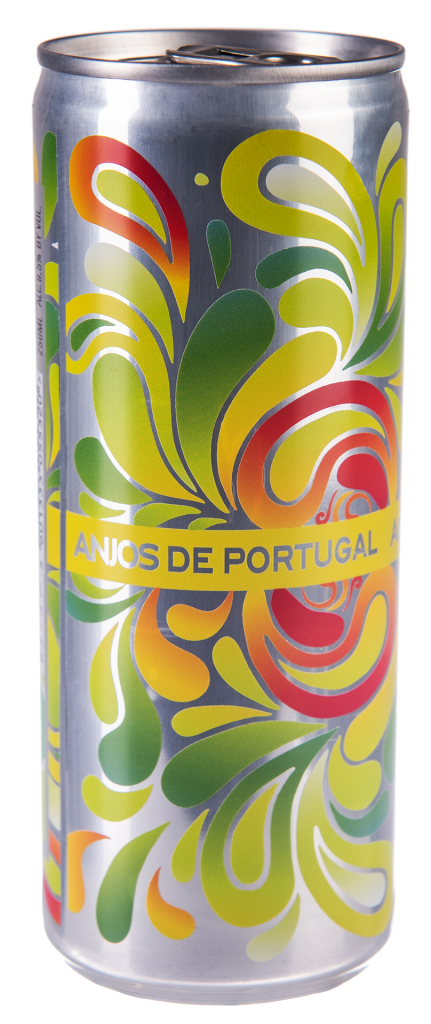On the tongue, Vinho Verde conjures a carefree spontaneity: We know it as a bright, spritzy, and youthful wine designed for casual drinking. These are ideal qualities, believes Oscar Meireles, of Quinta da Lixa, to sell it in a can. In July 2021, Quinta da Lixa and Ponte da Barca, two of the larger producers in the Vinho Verde region, petitioned the CVRVV (Comissão de Viticultura da Região dos Vinhos Verdes), a regional commission of over 16,000 members, to tweak one of its longstanding rules. In April 2022, the rule was approved by the Portuguese government, and entered into law. Vinho Verde could now be packaged and sold in 250-ml cans as well as traditional glass bottles.
“The idea is to make it possible to drink wine in places where glass is not allowed,” Meireles writes, citing popular summer destinations such as pools, beaches and music festivals. José Oliveira, of Ponte da Barca, cites the can’s appeal to younger people—“without the need for a corkscrew or glasses.”


This isn’t to say that wine from this northwestern corner of Portugal hadn’t been canned before. Last year, Quinta da Lixa released its effervescent, low alcohol, Anjos de Portugal label in single-serving 250-ml cans. Distribution was limited to the United States, and priced at $4.50 to $5 a pop. Gazela and Gatão, popular brands in Portuguese supermarkets, also debuted 250-ml aluminum versions of their Vinho Verdes. “Easy to open; even easier to enjoy,” chirped a 2021 post from the @Gazelawineusa Instagram account. In addition to the UnitedStates, Gazela cans also appeared in Portugal, Angola, Norway and Russia.
These containers couldn’t bear the Designation of Origin’s (DO’s) official seal of guarantee, even though the liquid inside checked all the boxes. Once sheathed in aluminum, Vinho Verde had to be declassified to the Minho Geographical Indication. “The [Minho label] is very unknown abroad, so the product loses value,” Oliveira writes.
The CVRVV doesn’t expect cans to dominate Vinho Verde production. “We are very traditional,” says Mafalda Coelho, international market manager at Quinta da Raza, an estate winery in Vinho Verde’s easterly Basto subregion. She doesn’t believe that most of her customer base, whether in Portugal or abroad, would spring for wine in cans.
The tradition of cork-finished bottles remains strong in the northern subregion of Monção and Melgaço. At Adega Coop Regional de Monção, the same wine sold with a screw cap in the United States is sold with a cork in Portugal. According to Ricardo Bastos, the winery’s international sales manager, his Portuguese customers often associate screw caps with lower quality wines. At Melgaço’s Soalheiro, winemaker Luis Cerdeira prefers cork’s natural tannins, and the “beautiful growth in the bottle” that this type of packaging will allow. “The advantage of the can,” Cerdeira explains, “is to show the market that Vinho Verde is not singular, it’s plural.” But Soalheiro doesn’t produce enough wine in volume to make cans feasible, anyway. Despite the ongoing glass shortage that has driven up the prices of bottles, packaging wine in a can is actually more expensive than bottling it. Perhaps that is why as of April, 2022, only Quinta da Lixa and Ponte da Barca have definitive plans to release canned Vinho Verde.
In export markets, which comprise 55 percent of Vinho Verde sales, expectations are high. “I have been thinking about putting Vinho Verde in the can for years,” says Corey Lahm, president of Green Bus Provisions, a Minneapolis-based import company with a portfolio of Portuguese wines. “I think cans are vessels where Vinho Verde can really shine.” While still a small market compared to bottles (according to Grand View Research, the global market for canned wine was valued at $211.4 million in 2020), those sales are expected to grow 13.2 percent from 2021 to 2028.


This summer, Ponte da Barca is releasing four canned Vinho Verde labels to the United States, as well as Portugal, Denmark, and Brazil. In five years, Oliveira hopes to sell cans in half of the winery’s 32 markets. Similarly, Meireles of Quinta da Lixa believes that cans could potentially make up 10 percent of Vinho Verde’s total volume of export sales. In 2021, Meireles sold 36,000 cans of Anjos de Portugal. This year, simply by using Vinho Verde’s seal of guarantee, he expects sales to double. He also hopes to expand to Canada, Japan, and Brazil, “markets where consumers are already used to drinking wines in cans.” The goal? Sales of 300,000 cans per year.
“The idea is to make it possible to drink wine in places like pools, beaches and music festivals.”
Oscar Meireles, Quinta da Lixa
Ryan Woodhouse, a buyer for California-based retailer K&L Wine Merchants, believes that if canned wine is here to stay, Vinho Verde has an excellent shot. “People have a weird conception in their heads that when they open a can, the beverage is going to be cold and sparkling,” he says, noting that sauvignon blancs and grenache-based roses have performed particularly well in the past. Vinho Verde’s fruity and aromatic profile, with a touch of effervescence, aligns with those expectations. Yet despite its populist appeal, canned wine isn’t necessarily a bargain. If three 250-mlcans make up a 750-ml bottle; those three cans might be 50 percent more expensive than a bottle priced at $9.99. Perhaps pricing, Woodhouse wonders, is the biggest hurdle canned Vinho Verde will face.
This story appears in the print issue of Summer 2022.
Like what you read? Subscribe today.

















